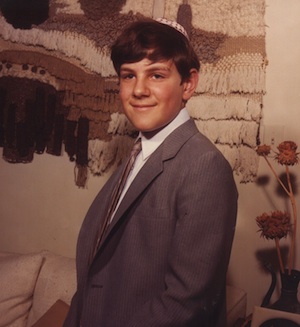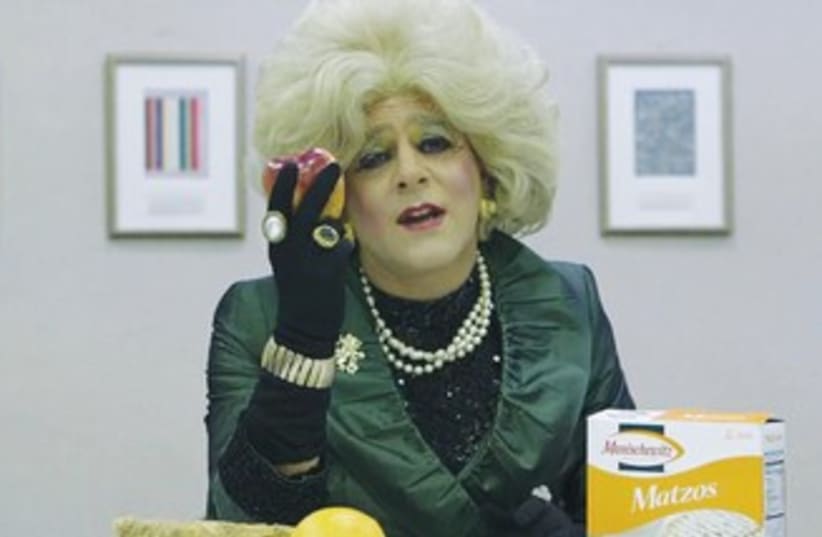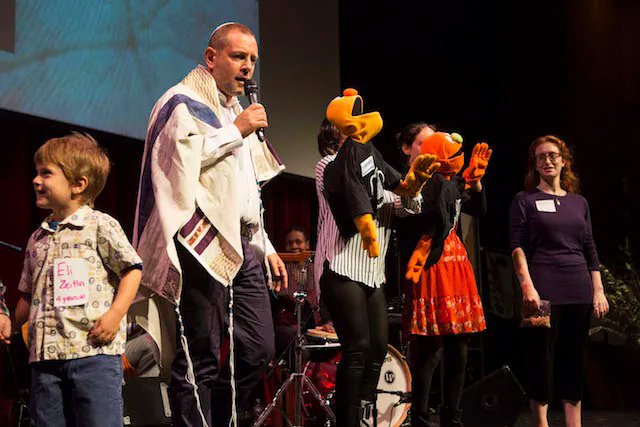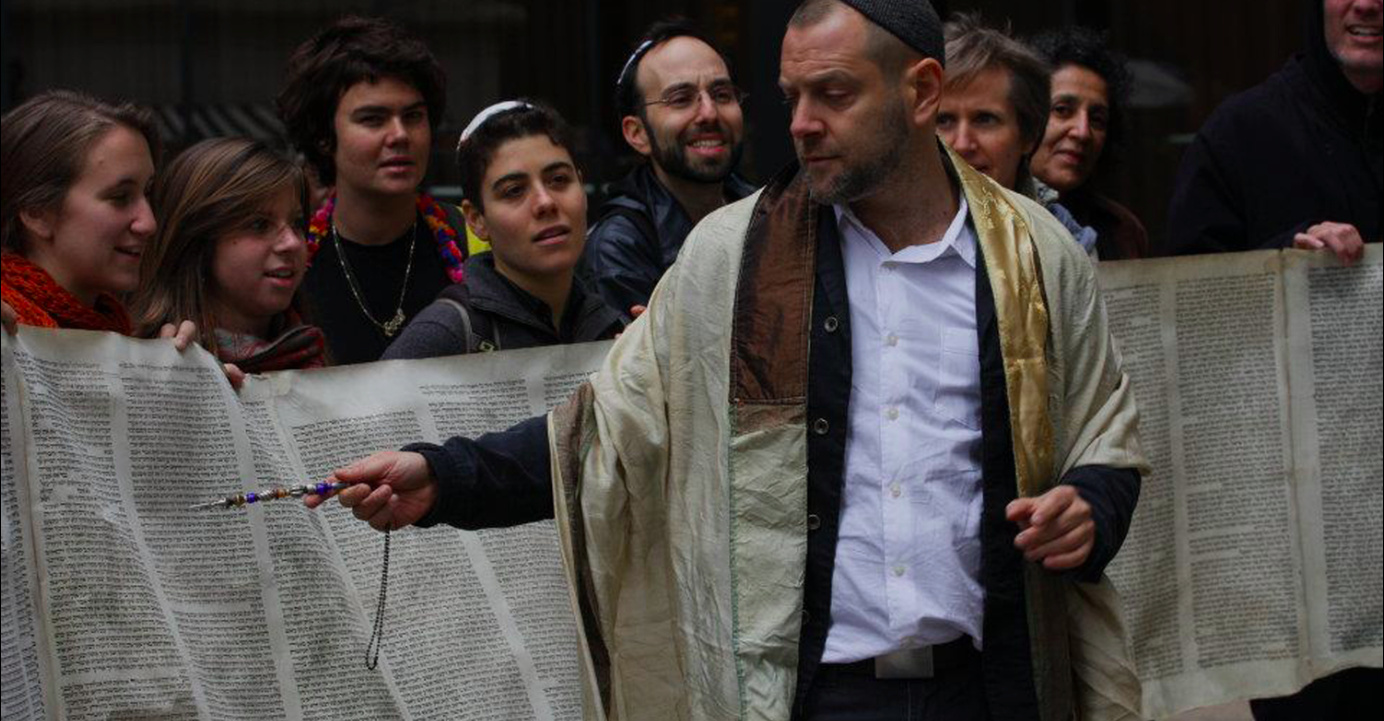Rabbi Amichai Lau-Lavie, Israeli born, has been living in New York City since 1998, where he’s at the forefront of fusing theater and storytelling with queerness, Jewish life and progressive politics. The 2024 documentary film by Sandi DuBowski, titled Sabbath Queen chronicles Amichai’s journey from his early drag-queen days to becoming one of America’s most prominent and popular rabbis.
Amichai is very much guided by his family’s legacy, with a rabbinic dynasty spanning 1,000 years. His parents had both lived through the Holocaust, and his father survived several concentration camps. His grandfather, chief rabbi of a Polish town, was murdered along with one of his sons in 1942, as he led his congregation to the gas chambers. Growing up in the shadow of this intergenerational trauma, Amichai became committed to the continuity of his family legacy - as well as to the pursuit of human rights for all. As a young man growing up in a religious Jewish home, and coming out, he realized that he had to make some big choices. His family’s history of persecution and being “othered” enabled a deep understanding of the way trauma has influenced our world systems, and what can be done to interrupt it. As a rabbi, he hopes to do so within the Jewish spiritual context: to talk back to the centuries of bias and generations of fear-based faith which he believes has to shift. He asks, “How do we get beyond the binaries of Jew-Gentile, Israeli-Palestinian, Straight-gay - to co-create a fusion future, where we are entrusted with each others’ well-being?” Amichai is committed to living in authenticity, to “coming out” in all the ways he can, and being an advocate for humanity and human dignity. He is toiling for a post-patriarchal Judaism, a queered tradition beyond binaries and beyond political boundaries that serve to separate people from working for a shared future.
Amichai was born in Israel in 1969 as the youngest of four, son of Naphatali, a journalist and diplomat, and Joan, a social worker. He attended Religious-Zionist schools in Ramat Gan and Bnei Brak, the center of Israeli ultra-orthodox Judaism. In 1982, his father became Israel’s Consul General in New York, and the family moved to the Upper East Side of Manhattan for four years, where he continued his studies in Orthodox schools. Amichai found Manhattan in the 80’s very exciting and described his teen years there as “very fun and hormone-fuelled.”
Since a very young age, Amichai has experimented with drag— especially on the Jewish holiday of Purim, where it is customary to dress in costume. His mother recounted to him how she raised her eyebrows when, as a little kid, he played with Barbies after synagogue services on Saturday mornings. Then once he came to New York, he had much more exposure to gay life.
 Amichai's Bar Mitzvah, New York City, April 1982At age 13, Amichai marked his coming of age through a bar mitzvah ceremony at an Orthodox synagogue in Manhattan. The weekly Torah portion he was set to chant was the very one that contained the prohibition against same-sex relations, Acharei Mot-Kedoshim. Amichai remembers that during the many months in which he was practicing how to chant these words, and as he was chanting them in front of the congregation that Saturday morning, he was thinking to himself, “Wow, this is so messed up. What do I do about it?” He was already aware of his sexual inclinations, and knew what the religion that his family practiced was demanding of him. Being made to publicly chant the verses calling same-sex relations abominable deeply affected him. Throughout Amichai’s teen years both in New York and later in Israel, he began questioning the cultural-religious matrix of his upbringing. Triggered by his questions of sexual identity in tension with Jewish law, he began challenging the existence and character of God, the validity of halacha (Jewish law) and the political ideologies of his parents and community. Feeling pulled in different directions, he experimented with taking his kippah (head covering) off and back on again.
Amichai's Bar Mitzvah, New York City, April 1982At age 13, Amichai marked his coming of age through a bar mitzvah ceremony at an Orthodox synagogue in Manhattan. The weekly Torah portion he was set to chant was the very one that contained the prohibition against same-sex relations, Acharei Mot-Kedoshim. Amichai remembers that during the many months in which he was practicing how to chant these words, and as he was chanting them in front of the congregation that Saturday morning, he was thinking to himself, “Wow, this is so messed up. What do I do about it?” He was already aware of his sexual inclinations, and knew what the religion that his family practiced was demanding of him. Being made to publicly chant the verses calling same-sex relations abominable deeply affected him. Throughout Amichai’s teen years both in New York and later in Israel, he began questioning the cultural-religious matrix of his upbringing. Triggered by his questions of sexual identity in tension with Jewish law, he began challenging the existence and character of God, the validity of halacha (Jewish law) and the political ideologies of his parents and community. Feeling pulled in different directions, he experimented with taking his kippah (head covering) off and back on again.
Back in Jerusalem, Amichai graduated from the Hartman High School for boys in 1986, and enlisted in the IDF in 1987 as part of the Ein Tzurim Yeshiva integration program, where his army service was combined with two years of Jewish studies. Amichai’s time in the IDF was physically and mentally grueling and ideologically challenging, serving at the time of the first intifada. He joined as a paratrooper, hoping to come off as macho and satisfy family expectations, “to show everybody that I’m not gay.” He received a gun during the first week of service, and feeling its heaviness loaded with cartridges and smelling the gun oil, he began tearing up, to his platoon mates’ derision. A couple months in, he found himself in a Palestinian village, asking himself what he was doing there, finding the tasks morally challenging. Amichai switched out of the paratroopers and became a combat medic, and later, a combat medic instructor. Throughout those years he kept questioning his religious and political identities and exploring gay life. As part of his army service program he spent a year studying at the Shalom Hartman Institute in Jerusalem. His time at Hartman was deeply influential in his ideological awakening, as it was his first introduction to deeply critical thinking about Judaism. At 19, it was becoming very clear to Amichai that he was no longer orthodox. This was partially due to his decision not to shun his sexuality, but he also could not find himself believing in the other aspects of orthodox ideology. In a formative night of conversation with his teacher Prof. David Hartman, Amichai fully confronted the ways in which he rejected orthodox halacha (Jewish law), and understood it was time for him to stop living under its rule. However, he kept this change of lifestyle private from his family.
Shortly after his night with David Hartman, he met his first boyfriend and moved in with him in Tel Aviv. When his father called him asking about his new roommate, Amichai denied any romantic relationship. His father offered to pay for therapy, which Amichai was delighted to accept. However, while it wasn’t full-on conversion therapy, he was seeing an orthodox psychoanalyst who wanted Amichai to explore a potential bisexuality or interest in women. This uncomfortable therapeutic relationship played a decisive role in cementing Amichai’s conclusion that he must make his own choices and move away from the familial context of his upbringing.
In 1994, when he was 22, Amichai was publicly outed by an Israeli gay journalist who published an article in the popular Israeli newspaper Maariv about the remote desert guest house where Amichai had been working after his army service. The article extolled Amichai’s creativity, mentioned that he was out as a gay man—although this was not yet the case—, and praised the accepting attitude of his family, in particular his uncle Rabbi Israel Lau who at the time was serving as Israel's Chief Ashekanzi Rabbi. The aftermath of the article became a turning point in Amichai’s life. Most of his extended family were surprised and refused to talk about it, although he did have meaningful conversations with his parents and siblings. From this rupture, Amichai was freed to explore the next chapters of his life: a fusion of Jewish education, storytelling and activism.
Working informally in education with Jewish youth and Israeli teens, Amichai began exploring the ways in which storytelling is a vital tool for engaging with personal identity and creative forms of Jewish expression. A formative event was the night on which Israel's Prime Minister Yitzchak Rabin was assassinated by a Jewish terrorist who grew up in the same ideological landscape as Amichai. For Amichai, this was a clarion call to invest more time and energy in creative, progressive and alternative paths to Jewish life that promote peace and pluralism, not hate and supremacy. He chose to do so through the power of storytelling. In his words, storytelling allows one “to talk back to the tradition we inherited, to look at the toxicity, the supremacy narratives, and the messianic narratives that Rabin’s assassin employed.”
In 1996-97, Amichai became involved in a few projects and experiments celebrating Jewish renewal and innovation, including an occasion on Purim, in which he performed in drag for the first time in his adult life. To illustrate the complex narratives of the holiday that is about ‘the other’, Amichai emerged on stage in front of hundreds of people as a Jewish-Nazi, wearing an SS uniform, a long, blond wig, and a lamb mask, introducing himself as “Heidy Cohen,” whose father was a nazi and whose mom was Jewish. On that night, Amichai truly understood the power of ritual theater and people still talk about the impact of that powerful night to this day.
In the mid-90s, he met Rabbi Steve Greenberg in Jerusalem and they started a gay religious men’s study group called “Moakh Gavra/ Man’s Mind.” Pre-Internet, they publicized this series with flyers in Jerusalem’s cafes and on trees. The group that assembled met in private homes for a few years before it folded into the newly established Open House, Jerusalem’s only LGBTQ center. They had quite a diverse attendance, haredi (ultra-orthodox) and ex-haredi, religious, and secular. This study group provided a novel and important fusion of queer religious identity, placing ancient Jewish texts in conversation with their own lives.
Amichai returned to NYC in 1997, for an artist-in-residence project at B'nai Jeshurun, a denominationally independent synagogue on the upper west side of Manhattan. The six month residency was successful and extended. During those years, he discovered the Radical Faeries, who helped him develop a spiritual queer identity— blurring the boundaries between irreverent and sacred, queer and religious. He also met Pie, his partner for the next few years at the Radical Faerie sanctuary in Tennessee.
 Rebbetzin Hadassah Gross's Pre-Passover Protest, March 2012 Amichai’s formative drag persona “Rebbetzin Hadassah Gross” emerged during this time as well. Hadassah provided an outlet for Amichai to be spiritual, religious, queer, and Jewish through playful performance. He later described Hadassah to be shamanic. Hadassah’s backstory has her born in Budapest, Hungary in the mid 1920’s, as a descendant of a Hasidic family. She survived the Holocaust, settled in America, and was the widow of six prominent rabbis, all of them related. She had established herself in the Jewish community and beyond as a personal soul-trainer to the ultra-orthodox elite. Her philosophy purports that, “A little bit of irreverence is very good for battling irrelevance. Humor is very important to touch the soul.” Hadassah has appeared before thousands worldwide in venues such as BAMcafe, The Ashkenaz Festival for New Yiddish Culture (Toronto), The Museum of Jewish Heritage, JCC Manhattan, JCC San Francisco, Burning Man Festival 2003, Lansky Lounge (NYC), the Belt Theater (NYC), Echo Club (LA) and the Limmud NY Conference. Hadassah was featured in the Channel 10 Israeli TV series “The Search for the 10 Commandments,” (March 2005), and in a feature cover article for Ha’Aretz Magazine (October 2004).
Rebbetzin Hadassah Gross's Pre-Passover Protest, March 2012 Amichai’s formative drag persona “Rebbetzin Hadassah Gross” emerged during this time as well. Hadassah provided an outlet for Amichai to be spiritual, religious, queer, and Jewish through playful performance. He later described Hadassah to be shamanic. Hadassah’s backstory has her born in Budapest, Hungary in the mid 1920’s, as a descendant of a Hasidic family. She survived the Holocaust, settled in America, and was the widow of six prominent rabbis, all of them related. She had established herself in the Jewish community and beyond as a personal soul-trainer to the ultra-orthodox elite. Her philosophy purports that, “A little bit of irreverence is very good for battling irrelevance. Humor is very important to touch the soul.” Hadassah has appeared before thousands worldwide in venues such as BAMcafe, The Ashkenaz Festival for New Yiddish Culture (Toronto), The Museum of Jewish Heritage, JCC Manhattan, JCC San Francisco, Burning Man Festival 2003, Lansky Lounge (NYC), the Belt Theater (NYC), Echo Club (LA) and the Limmud NY Conference. Hadassah was featured in the Channel 10 Israeli TV series “The Search for the 10 Commandments,” (March 2005), and in a feature cover article for Ha’Aretz Magazine (October 2004).
When her story became too aggrieved and complex, and for personal reasons, Amichai let Hadassah take a hiatus starting Purim 2013, and this hiatus is ongoing— “she’s not dead.” She began her time-out by submerging in the Dead Sea, to embark on a worldwide expedition to rescue “the Divine Feminine (Shekhinah) from the paws of patriarchy.” While working at B'nai Jeshurun in the late 1990’s, in the area of adult education, Amichai began seeking to create space for people to talk back to Torah,” to turn the traditional weekly Torah reading rituals into a more exciting and interactive dialogue. With inspiration from the Faeries and his studies at the LaMaMa experimental theater, Amichai founded the ritual theater troupe StorahTelling, training people in its model of theater education.
 StorahTelling, Lab/shul High Holy Days Family Gathering, NYC 2013
StorahTelling, Lab/shul High Holy Days Family Gathering, NYC 2013
StorahTelling was founded as a nonprofit organization with the tagline ‘Jewish Ritual Theater Revived’. Amichai added artists and activists, many of them Queer, and the group grew quickly to create theatrical programs and ritual events. After 9/11, Amichai faced his old questions with renewed urgency. What do we do with our religious narratives which are fundamentalist and hostile? They began to take on more interfaith work and explore religious narratives from around the world. In 2010, the group realized that they did more than just ritual theater— they had become a community of seekers, with a growing audience of fans and friends. In 2013, they officially rebranded as Lab/Shul - a congregation which is an “artist driven, everybody-friendly, God-optional, pop-up, experimental community for sacred Jewish gatherings, based in NYC, reaching the world.”
Amichai became Lab/Shul’s founding spiritual leader, partnering with other creative and talented artists and educators. But as the shift started to take place he decided to also become a rabbi and lead the community with these commonly recognized credentials. On his father’s side, he is the 39th generation of rabbis. He decided to take on his family’s rabbinic legacy and queer it.
 Lab/Shul Unscrolled Ritual at Occupy Wall Street, NYC 2011
Lab/Shul Unscrolled Ritual at Occupy Wall Street, NYC 2011
In 2010, he enrolled at the Jewish Theological Seminary of America, and graduated in 2016. While JTS welcomed LGBTQ students, its Jerusalem-based partner institution, The Schechter Institute, did not. In response, Amichai and a fellow gay student began a serious activism campaign, and successfully convinced most of their classmates to refuse to attend Schechter in solidarity. In April, 2011, Schechter changed their policy. It was a huge win and enabled Amichai and other LGBTQ students to study there, and enabled the communal culture to shift.
Upon graduating, Amichai joined the Rabbinical Assembly of the Conservative movement, to fulfill his hopes of having a stronger voice among changemakers. However, as a rabbi committed to his congregation Lab/Shul of many diversely-Jewish & interfaith families, Amichai resigned from the RA in order to openly officiate interfaith weddings. He spent a year writing the JOY Proposal, a Jewish legal responsum which uses biblical and historical precedents to sanctify a paradigm of interfaith relationships, which came out to public acclaim and some public controversy, in 2017.
Amichai is the bio-dad of three children, who were born to and raised by a lesbian couple living in New York City. He is an active presence in the children’s lives and his family of origin has embraced them as part of the family.
Amichai continues to be engaged in many forms of activism and artistic innovation, both in the U.S. and in Israel and Palestine. Rabbi Amichai serves on the Executive Board of Rabbis for Human Rights, is a co-founding member of the Jewish Emergent Network, a founding faculty member of the Reboot Network, and serves on the Advisory Board of the Sulha Peace Project for Israeli and Palestinian peacemakers, the Leadership Council of the New York Jewish Agenda, the Advisory Council for the Institute for Jewish Spirituality and as an advisor to Jerusalem Open House for Pride and Tolerance.
(This biographical statement written by Charlie Feuerman from an interview with Amachai Lau-Lavie and from these sources: “Becoming a Man: My Bar Mitzvah Speech Thirty Years Later By Amichai Lau Lavie.” Rebar, 21 Oct. 2014, http://www.rebarproject.org/wrestling-with-the-torah1/2014/10/21/becoming-a-man-my-bar-mitzvah-speech-thirty-years-later and Creative, Cornershop. “Homepage.” Lab/Shul, https://www.labshul.org/. Accessed 6 June 2024.)
Biography Date: June 2024